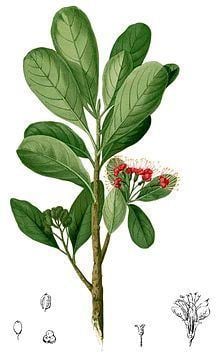Rank Species | ||
 | ||
Scientific name Xanthostemon verdugonianus Similar Xanthostemon, Koordersiodendron pinnatum, Chionanthus foveolatus, Acacia estrophiolata, Nestegis apetala | ||
Xanthostemon verdugonianus is a species of plant in the Myrtaceae family. It is endemic to the Philippines. It is threatened by habitat loss.
Characteristics
Magkono, scientifically called Xanthostemon verdugonianus Naves, is known to be the hardest Philippine hardwood species. Cutting a 70-cm thick tree with axes normally requires three hours, but cutting a Magkono tree with the same diameter usually takes two to four days. Diamond-point saws have been used exclusively but a great volume of water is needed to counter overheating.
Because of its inherent hardness and high density, Magkono has long been recognized as a substitute for the world-famous Lignum vitae (Guaicum officinale L.). Magkono is an excellent material for the bearing or stern bushing of a steamship’s propeller shaft. Its other uses are as rollers, shears, saw guide blocks, tool handles, novelties, poles and piles for wharves and bridges, and posts for houses.
Magkono is a medium-sized-tree reaching a diameter of 50 cm or more with a very irregular, fluted and bent bole frequently with epidermic branches.
Leaves are simple, relatively thick, alternate, obovate, 8–12 cm long and 3–5 cm wide. Its red inflorescence terminates in a branch. The fruit is dehiscent and has 2-3 lobes that split into 2-3 sections when ripe and contain tiny half-moon shaped seeds.
The species is endemic to the Philippines and is known to have a very limited habitat. It is indigenous only within the so-called ‘Magkono Triangle’ area, consisting of the Dinagat Island in Surigao, the Homonhon Island in Samar, Babatngon, Leyte, and in Palawan.
Status: Rare and Endangered
